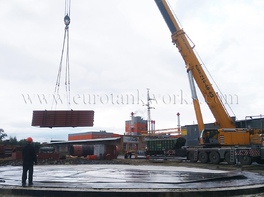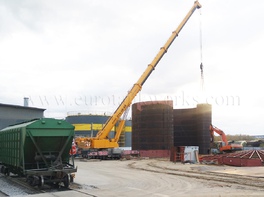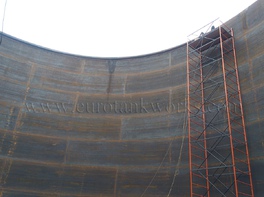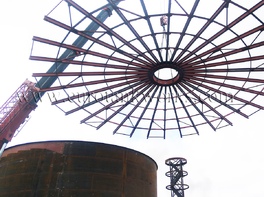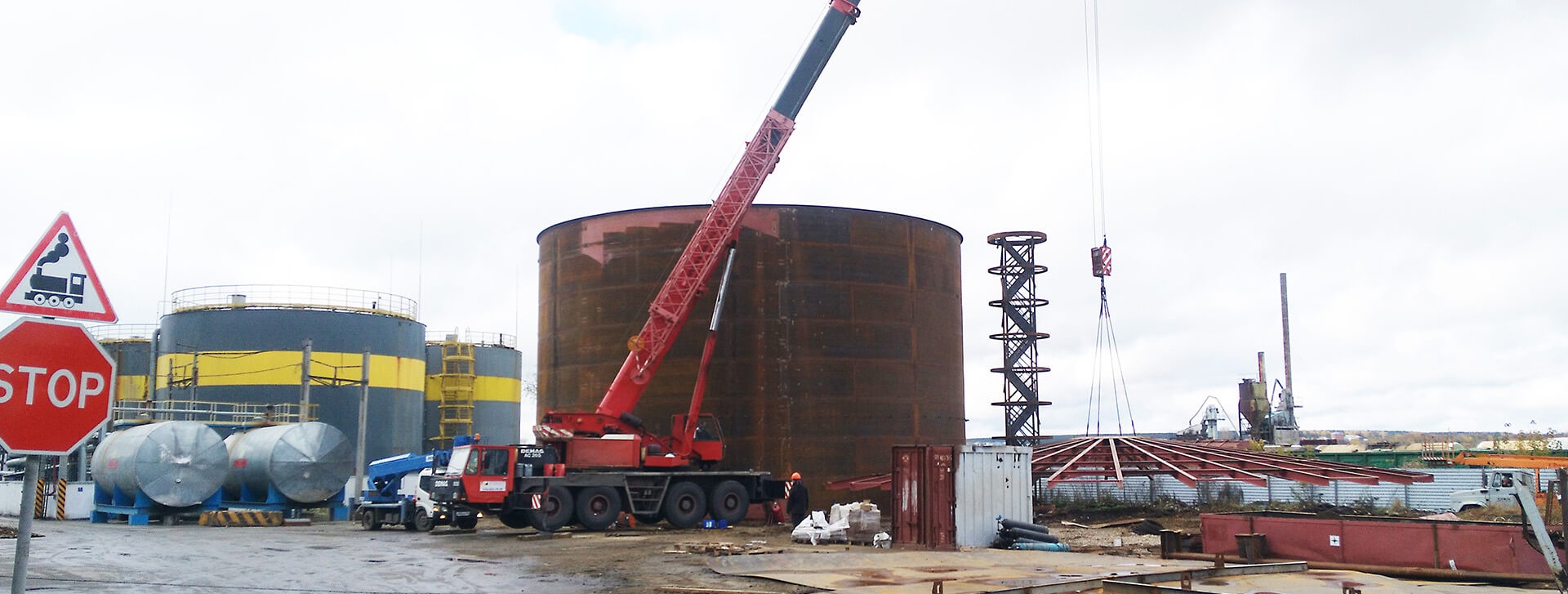7.1. Methods of quality control of the welding joints in the course of assembly works




Quality control of the welding joints in the course of tank construction should imply:
- The use of welding methods, ways and scope of control of the welding joints, applicable to the tank’s importance level;
- The use of effective technological welding procedures and materials according to the stipulations of metal frameworks plan and Work Execution Plan;
- Carrying out technical and construction design supervision.
The table contains information on methods of quality control of the welding joints, applicable depending on the controlled element of the tank:
| Control zone |
Control method |
| visual and measuring |
vacuum |
radio |
ultrasonic |
capillary (color) |
overpressure |
| BOTTOM |
| Bottom joints |
+ |
+ |
- |
- |
- |
- |
| Bottom joints at a distance of 250 mm from the outer edge |
+ |
+ |
+ |
- |
- |
- |
| SHELL |
| Vertical joints of the 1st and 2nd zones |
+ |
- |
+ |
+¹ |
- |
- |
| Vertical joinsof remaining zones |
+ |
- |
+² |
+ |
- |
- |
| Horizontal joints |
+ |
- |
+² |
+ |
- |
- |
| Crosshairs of vertical and horizontal joints |
+ |
- |
+ |
- |
- |
- |
| Branch pipe-to-shell joints |
+ |
+ |
- |
+ |
- |
- |
| Joint between a collar of a branch pipe (hatch) and 1m a belt of a shell |
+ |
- |
- |
- |
+ |
+ |
| Joint between a collar of a branch pipe (hatch) and a wall (except for the 1st belt) |
+ |
- |
- |
- |
- |
+ |
| Radial joints of stiffening rings |
+ |
- |
- |
- |
- |
+ |
| Spots of removal of assembly devices, welded joints of structural elements after their heat treatment |
+ |
- |
- |
- |
+ |
- |
| Bottom-to-shell joint |
+ |
+ |
- |
- |
+ |
- |
| ROOF |
| Radial joints of the support ring |
+ |
- |
- |
+ |
- |
- |
| Joints of roofing, roofing shields |
+ |
+ |
- |
- |
- |
+ |
| Branch pipe-to-roof joints |
+ |
+ |
- |
- |
- |
- |
| FLOATING ROOF |
Joints of boxes (compartments) and plugs of racks
|
+ |
- |
- |
- |
- |
+ |
| Joints of the central part |
+ |
+ |
- |
- |
- |
- |
| Branch pipes-to-roof joints |
+ |
+ |
- |
- |
- |
- |
1 allowed the use of ultrasonic testing
2 allowed the use of radiography
3 control breakdown «chalk-kerosene» hold up welding joint from the inner side |
The scope of physical control of welding joints (in percentage to the joint’s length) of the tank shell, depending on the tank’s class of hazard, should correspond to the requirements of the table:
| VOLUMES of the PHYSICAL CONTROL of WELDED JOINTS of TANK SHELL, as % of the length of the seam |
| Control zone |
hazard class |
| |
IV |
III |
II |
I |
| |
|
1 000 – 10000m³ |
10000 –20000m³ |
|
|
| vertical welded connections: |
| in zones 1-2 |
20% |
25% |
50% |
100% |
100% |
| in zones 3-4 |
5% |
10% |
25% |
50% |
100% |
| in zones 5-6 |
2% |
5% |
10% |
25% |
50% |
| the zones above the 6-th |
- |
- |
5% |
10% |
25% |
| horizontal welds: |
| in zones 1-2 |
3% |
5% |
10% |
15% |
20% |
| in zones 3-4 |
1% |
2% |
5% |
5% |
10% |
| in zones 5-6 |
- |
- |
2% |
2% |
5% |
| in other zones |
- |
- |
- |
2% |
2% |
While choosing the areas of control the prevailing attention should be paid to the areas of joints’ crossing.
Assembly butt-joints of the tanks installed with coiled method with the loading capacity from 1000 m³ and more must be controlled on the full length of the joints.
The results of tests and quality control of the welding joints are fixed in certificates and acts and represent the essential supplements to the documents for the tank.
7.2. Final tests after the oil storage tank construction
The final stage of the tank testing is the hydraulic pressure test, meant to check the tightness of connections and the durability of construction on the whole.
Tanks with fixed roof without a pontoon are additionally subject to extra pressure and relative under pressure from the inside.
The table below stipulates the tests that need to be done for tanks of different types (1 - tanks with fixed roof without a pontoon, 2 - tanks with fixed roof and a pontoon, 3 - tanks with floating roofs).
| № |
type of test |
1 |
2 |
3 |
| 1 |
Watertight test |
+ |
+ |
+ |
| 2 |
Strength test of tank body under hydrostatic load |
+ |
+ |
+ |
| 3 |
Air pressure tightness test of a fixed roof |
+ |
- |
- |
| 4 |
Test the stability of the tank body by creating a relatively rarefaction inside the tank |
+ |
- |
- |
| 5 |
Buoyancy test of floating roof |
- |
+ |
+ |
| 6 |
Rolling ladder performance test |
- |
- |
+ |
| 7 |
Testing the stability of the base of the tank with the determination of absolute and uneven draft along the contour of the bottom, roll of the tank profile of the central part of the bottom |
+ |
+ |
+ |
Hydraulic pressure test of the tanks with floating roofs or a pontoon are done before installing the rim seals.
The tests of a tank of any type are carried out based on the testing program, included in the metal framework design project and Work Execution Plan.
The testing program should include:
- Stages of testing, stipulating the level of loading/discharge of water and curing time;
- Rates of excessive pressure and relative under pressure, test curing time;
- Scheme of visual inspection;
- Demands for measuring the necessary geometrical parameters of the construction elements of the tank and its foundation;
- Testing results’ processing, checking calculations (if necessary), final report on usability and operating regime of the tank.
7.2.1. Hydraulic pressure tests of a tank
In the course of hydraulic pressure test the tank is gradually filled with water to the planned level. The loading is performed in stages with certain time gaps, meant for supervising its settlement and the state of welding joints, and for carrying out other measuring and inspection, stipulated by the testing program.
If leaking from under the edge of the bottom or in the first ring of the shell is revealed in the course of testing, the water is fully discharged (removed). If cracks are revealed in the shell seams the water is discharged to the level lower than the discovered defect. If the defect appears in the 2nd-6th ring, the water is removed to the level one ring lower the defect. If the defect appears in the 7th ring and higher – the water is removed to the 5th ring. After the defects are eliminated the testing goes on.
Tanks for storing liquid materials with the mass density, exceeding that of water, as well as the tanks, installed at sites without water availability, can be tested with the product itself. Prior to such tests all welding joints of the shell, bottom, roof and manway plates/fitting pipes, and also connections of shell with the roof and the bottom should be tested for leak tightness.
The tank filled to the planned level must be kept under load within the following period:
- Vertical steel tank V≤10000 m³ — 24 hours;
- Vertical steel tank V=10000-20000 m³ — 48 hours;
- Vertical steel tank V≥20000 m³ — 72 hours.
The tank is considered to pass the test if no leaking appears on its surface of at the edges of the bottom within the test period, if the level of test product does not decrease, if the settlement (sinking) of the foundation and basement becomes stable.
The hydraulic pressure test is recommended to be carried out at the temperature level not less than +5 °С. If the test is done in winter period the water should be heated, or its permanent circulation should be provided so as to prevent its freezing in the pipes and gate valves, and to prevent frosting of the tank shell.
7.2.2. Pressure/under pressure testing for the tank’s body and roof:
Fixed roof of a tank without a pontoon is tested for excessive pressure with the tank filled to the level, which is 10 % lower the planned level, with keeping the load for 30-minutes. The pressure is provided by the flow of water with all roof manway plates tightly closed. In the course of testing the full visual inspection of welding joints of the fixed roof is done.
The steadiness of the tank body is checked by relative under pressure inside the tank, filled with water to the level of 1.5 m, keeping the tank under the load within 30 min. The relative under pressure is provided by the discharge of the liquid product with all manway plates tightly closed. If no signs of unsteadiness are revealed (no canning, no buckles), the shells and roofs are considered to pass the test for relative under pressure.
The excessive pressure is applied at the rate of 25 % higher the planned level, the relative under pressure – 50 % higher the planned level, if the design documents do not contain other demands.
After the acceptance test is done, it is not allowed to weld any construction elements to the tank. It is possible to perform corrosion preventive procedures, heat insulation and installation of equipment, stipulated in the design documents.
After the hydraulic pressure testing is done, the actual technical condition of the tank’s metal framework, basement and foundation should be evaluated.
7.2.3. The basic demands for the arranging and performing the tests:
The final testing of a tank for durability, steadiness and leak tightness is done after all welding and assembly procedures are over, the quality of all construction elements, including welding seams, is checked and accepted by the technical supervision organization.
All tests are done according to the technological chart, included in Work Execution Plan. Technological chart should include:
- The order and regime of the hydraulic pressure test;
- The order and regime of testing for excessive pressure and vacuum;
- Arrangement of temporary pipelines for water loading and discharging with safety and shutoff valves’ installation;
- Control panel;
- Labor safety requirements in the course of testing.
Temporary pipeline for water loading and discharging should be arranged outside the area of embanking. The scheme of water discharge is worked out for each particular case. In the course of testing the water is often pumped from one tank to another, and from the last one to the firefighting tank of temporary water body.
Diameter of the pipeline for loading and discharging water should correspond to the estimated level of loading-discharge operations’ efficiency.
Apart from the operation scheme of flow and discharge of water, an emergency unloading scheme should be foreseen in case cracks appear on the tank’s body. For emergency purposes it is recommended to use one of the intake-dispensing fitting pipelines and technological pipeline with a valve outside the area of embanking.
It is essential to set and specially mark with preventing and safety signs the borders of danger zone for the testing period. If an embanking or a protective shell is arranged round the tank, they are considered to be the border of the danger zone. In case the tank is installed without embanking, the limits of the danger zone are determined by the radius, drawn from the center of the tank for the distance equal to two diameters of the tank.
The testing is done by the assembly organization accompanied by representatives of technical supervision service and construction design supervisor. After the tests are finished, the installation specialists and the ordering customer sign a certificate (an act), stating the finish of the metal frameworks’ installation and acceptance of the tank for further corrosion preventive procedures, installing equipment and other works.










